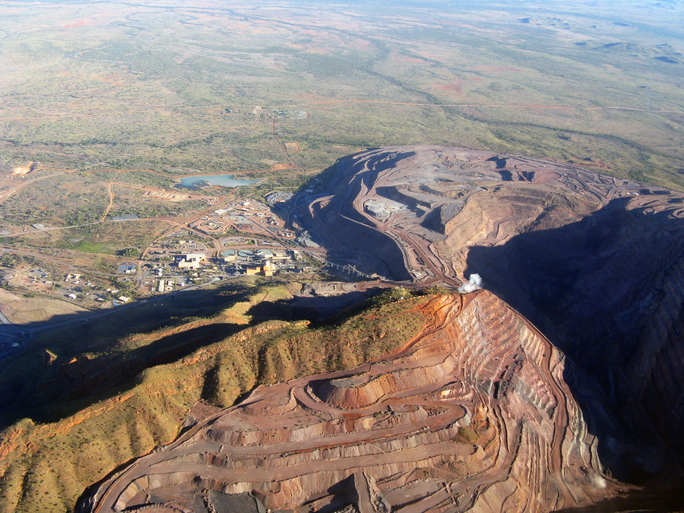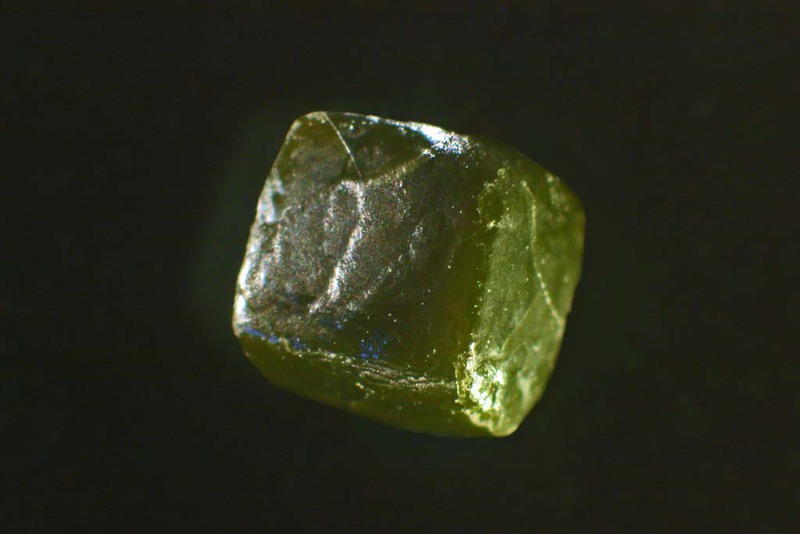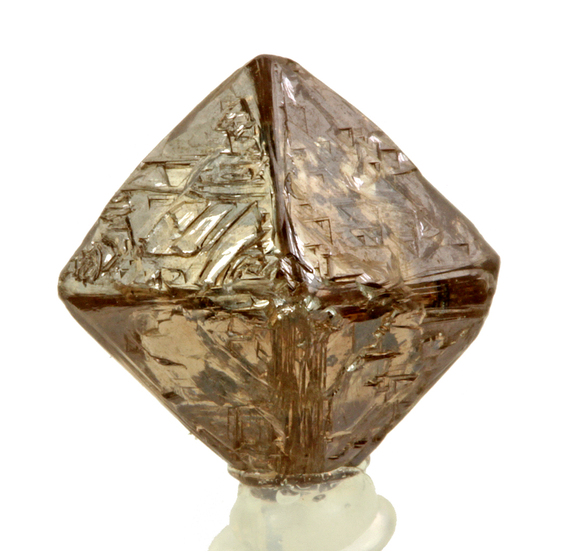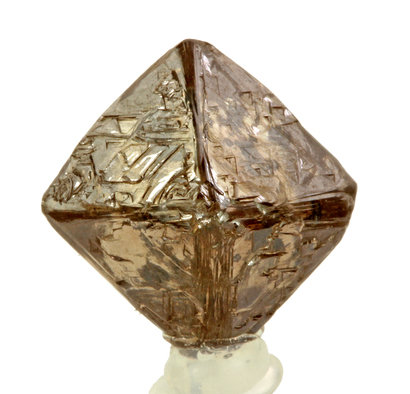Argyle Diamond Mine, Lake Argyle area, Wyndham-East Kimberley Shire, Western Australia, Australiai
| Regional Level Types | |
|---|---|
| Argyle Diamond Mine | Mine |
| Lake Argyle area | Area |
| Wyndham-East Kimberley Shire | Shire |
| Western Australia | State |
| Australia | Country |
This page is currently not sponsored. Click here to sponsor this page.
Latitude & Longitude (WGS84):
16° 42' 59'' South , 128° 23' 20'' East
Latitude & Longitude (decimal):
Type:
Köppen climate type:
Mindat Locality ID:
4301
Long-form identifier:
mindat:1:2:4301:7
GUID (UUID V4):
709bafbc-6801-4662-96af-0f8cc4be006c
Other/historical names associated with this locality:
Argyle Mine; Argyle open pit; Argyle AK1 pipe
Located a few miles South of Lake Argyle.
A large diamond-bearing lamproite pipe discovered by Ashton Joint Venture in 1979.
The mine commenced in 1983 with the pit becoming operational in 1985 and operated to November 2020. Underground mining commenced from 2013.
From 1983 to 2017 the mine produced more than 800 million carats of rough diamonds [per Rio Tinto 2017].
Argyle's production consisted of 5% gem and 70% near-gem stones, with the remaining 25% being industrial diamonds.
The mine also produced between 90% and 95% of the world's highly priced pink diamonds.
Rio Tinto's Argyle Diamond Mine was the largest producer of natural diamonds in the world.
Exploration for diamonds in the Kimberley region started in 1972 by Ashton Mining Ltd, as Ashton Joint Venture led by Maureen Muggeridge, then by CRA Ltd in 1976, later taken over by Rio Tinto. Apart from an area of diamond pipes in the Ellendale district in the west Kimberley, little was found.
In 1979 diamonds were found in Smoke Creek in the east Kimberley. These were found by Lyn Tagliaferri who was part of the exploration team, who initially thought they had been placed there by the company to test the worth of the team. She arrived back at the exploration camp announcing: 'I have found the test diamonds'. It led to a mad scramble to locate the source of the diamonds. It was followed upstream to the source of the diamonds later known as the AK1 pipe. It is said the pipe was located after a diamond was spotted embedded in an anthill. It could be argued credit for the discovery of the diamond pipe should go to the ant colony.
What followed next was secrecy which would put the CIA to shame. The AK1 pipe area was held by another company under lease exploring for uranium. CRA had to wait for this lease to expire without anyone finding out about the diamonds in the meantime. Due to the remote nature of the location, only HF radio was available and all communication was done in code. All available maps of the area were purchased, all available 4 wheel drives and helicopters hired in an effort to slow any other company. A large block of tenements was staked in the west Kimberley to throw off any other company that got wind of the discovery.
Alluvial mining started in 1983 and is now exhausted. Open pit mining started in 1985 and then wound down through 2012 in favour of underground mining in 2013.
The last truckload of diamond-bearing ore was brought to the surface on November 3, 2020 (NY Times 11-17-2020).
Geology
The volcanic pipe is a diatreme of olivine lamproite as tuff and lava. The diamonds are found in lamproite rather than the usual kimberlite. The Argyle Pipe consists of quartz-sand tuff, non-sandy tuff, and cross-cutting olivine lamproite. The highest grades of diamonds are found in the sandy tuff at 3-30 carats per tonne, with lower amounts in the other two rock types.
The sandy tuff is composed of volcanic clasts of olivine lamproite, exotic clasts of sandstone and shale. The fine-grained volcanic matrix has been partly recrystallised to a hard potassium-feldspar. The clasts range from blocky to highly vesicular. The dark green-brown blocky clasts were formed from rapid chilling when the hot magma hit water. Nearly all the primary minerals in the lamproite have been altered. Only phlogopite and chromite have survived alteration. In the northern section of the pipe, the sandy tuff is well bedded showing low angle cross-bedding, scour and fill channels, accretionary lapilli, and water escape structures.
Non-sandy tuff is composed of olivine lamproite clasts in a finer-grained altered ash matrix. The lamproite dykes have been altered to either olivine phlogopite lamproite, or phlogopite olivine lamproite, and cross cut the sandy tuffs as a late stage intrusion.
At the margins of the pipe is shattered fragmented volcanic breccia. This marginal area contains zeolites, mica, kaolinite, and clays. Diamonds are found in the core, and to a lesser extent in the marginal area. The diamonds formed in a relatively rapid period of 400 million years, 1.58 billion years ago. The rapid development may explain how many of the diamonds from the mine show odd shapes, etched surfaces, and stressed crystal structures.
The magma is thought to have violently exploded at the surface under a shallow water body with a sandy floor. The water caused the magma to flash to steam, causing an excavation of the vent, which worked its way downwards for hundreds of metres. Within the vent at this time was a chaotic and turbulent mix of hot tuff, water, and sand pouring into the vent from the surface. This violent mixing is seen to explain the lack of stratigraphy in the pipe.
Diamonds from the mine tend to fluoresce blue or dull grey under UV light, and blue-white under X-ray radiation. As part of a marketing campaign, the gemstone formerly known as brown diamond was re-named champagne and cognac diamonds. Pink, blue and red diamonds are sold at auction to invited buyers.
In 2012, Rio Tinto announced they had recovered Australia's largest pink diamond at 12.76 carats, subsequently named The Argyle Pink Jubilee. Unfortunately, it wasn't left in its rough natural state and underwent cutting and faceting. Red diamond is one of the rarest gemstones in the world. The mine produces half a teaspoon of red diamonds per year, and they sell for half a million dollars upwards per stone. Garden variety rough diamond specimens from the mine are readily available for sale. The United States acts as a diamond sink as it is illegal to export diamonds from the country, even back to the stone's country of origin.
The AK1 pipe is the type locality for lucasite-(Ce), which is found as brown subhedral 0.5-1mm grains in the non-sandy olivine lamproite tuff. The species is named after Hans Lucas from CRA Exploration Pty Ltd who noticed the new species in the heavy mineral concentrate they were processing.
Select Mineral List Type
Standard Detailed Gallery Strunz Chemical ElementsCommodity List
This is a list of exploitable or exploited mineral commodities recorded at this locality.Mineral List
42 valid minerals. 1 (TL) - type locality of valid minerals.
Rock Types Recorded
Note: data is currently VERY limited. Please bear with us while we work towards adding this information!
Select Rock List Type
Alphabetical List Tree DiagramDetailed Mineral List:
| ⓘ Almandine Formula: Fe2+3Al2(SiO4)3 |
| ⓘ 'Almandine-Pyrope Series' |
| ⓘ Anatase Formula: TiO2 References: |
| ⓘ 'Apatite' Formula: Ca5(PO4)3(Cl/F/OH) References: |
| ⓘ Baryte Formula: BaSO4 |
| ⓘ Calcite Formula: CaCO3 References: |
| ⓘ Chalcopyrite Formula: CuFeS2 References: |
| ⓘ 'Chlorite Group' |
| ⓘ Chromite Formula: Fe2+Cr3+2O4 References: |
| ⓘ 'Clinopyroxene Subgroup' |
| ⓘ Coesite Formula: SiO2 |
| ✪ Diamond Formula: C References: Olierook, Hugo K. H., Fougerouse, Denis, Doucet, Luc S., Liu, Yebo, Rayner, Murray J., Danišík, Martin, Condon, Daniel J., McInnes, Brent I. A., Jaques, A. Lynton, Evans, Noreen J., McDonald, Bradley J., Li, Zheng-Xiang, Kirkland, Christopher L., Mayers, Celia, Wingate, Michael T. D. (2023) Emplacement of the Argyle diamond deposit into an ancient rift zone triggered by supercontinent breakup. Nature Communications, 14 (1) doi:10.1038/s41467-023-40904-8 |
| ⓘ Diopside Formula: CaMgSi2O6 |
| ⓘ Diopside var. Chromium-bearing Diopside Formula: Ca(Mg,Cr)Si2O6 References: |
| ⓘ Dolomite Formula: CaMg(CO3)2 |
| ⓘ Enstatite Formula: Mg2Si2O6 References: |
| ⓘ 'Fayalite-Forsterite Series' References: |
| ⓘ 'Feldspar Group' |
| ⓘ Forsterite Formula: Mg2SiO4 |
| ⓘ Galena Formula: PbS |
| ⓘ 'Garnet Group' Formula: X3Z2(SiO4)3 References: |
| ⓘ Hematite Formula: Fe2O3 |
| ⓘ Ilmenite Formula: Fe2+TiO3 |
| ⓘ Jeppeite Formula: (K,Ba)2(Ti,Fe)6O13 |
| ⓘ Kaolinite Formula: Al2(Si2O5)(OH)4 |
| ⓘ 'K Feldspar' References: |
| ⓘ Kyanite Formula: Al2(SiO4)O |
| ⓘ Leucite Formula: K(AlSi2O6) References: |
| ⓘ Lizardite Formula: Mg3(Si2O5)(OH)4 |
| ⓘ Lucasite-(Ce) (TL) Formula: CeTi2(O,OH)6 Type Locality: |
| ⓘ Magnesiochromite Formula: MgCr2O4 References: |
| ⓘ Magnetite Formula: Fe2+Fe3+2O4 |
| ⓘ 'Mica Group' |
| ⓘ Moissanite Formula: SiC |
| ⓘ Orthoclase Formula: K(AlSi3O8) |
| ⓘ 'Orthopyroxene Subgroup' |
| ⓘ Pentlandite Formula: (NixFey)Σ9S8 References: |
| ⓘ Phlogopite Formula: KMg3(AlSi3O10)(OH)2 References: |
| ⓘ Priderite Formula: K(Ti4+7Fe3+)O16 References: |
| ⓘ Pyrite Formula: FeS2 |
| ⓘ Pyrope Formula: Mg3Al2(SiO4)3 |
| ⓘ 'Pyroxene Group' Formula: ADSi2O6 References: |
| ⓘ Pyrrhotite Formula: Fe1-xS |
| ⓘ Quartz Formula: SiO2 References: |
| ⓘ Richterite Formula: Na(NaCa)Mg5(Si8O22)(OH)2 |
| ⓘ Rutile Formula: TiO2 References: |
| ⓘ Selenium Formula: Se |
| ⓘ 'Serpentine Subgroup' Formula: D3[Si2O5](OH)4 |
| ⓘ Sphalerite Formula: ZnS References: |
| ⓘ Spinel Formula: MgAl2O4 References: |
| ⓘ Talc Formula: Mg3Si4O10(OH)2 References: |
| ⓘ Tetraferriphlogopite Formula: KMg3(Fe3+Si3O10)(OH,F)2 References: |
| ⓘ Titanite Formula: CaTi(SiO4)O References: |
| ⓘ Wadeite Formula: K2Zr(Si3O9) |
| ⓘ Zircon Formula: Zr(SiO4) |
List of minerals arranged by Strunz 10th Edition classification
| Group 1 - Elements | |||
|---|---|---|---|
| ⓘ | Diamond | 1.CB.10a | C |
| ⓘ | Selenium | 1.CC.10 | Se |
| ⓘ | Moissanite | 1.DA. | SiC |
| Group 2 - Sulphides and Sulfosalts | |||
| ⓘ | Pentlandite | 2.BB.15 | (NixFey)Σ9S8 |
| ⓘ | Sphalerite | 2.CB.05a | ZnS |
| ⓘ | Chalcopyrite | 2.CB.10a | CuFeS2 |
| ⓘ | Pyrrhotite | 2.CC.10 | Fe1-xS |
| ⓘ | Galena | 2.CD.10 | PbS |
| ⓘ | Pyrite | 2.EB.05a | FeS2 |
| Group 4 - Oxides and Hydroxides | |||
| ⓘ | Magnesiochromite | 4.BB.05 | MgCr2O4 |
| ⓘ | Spinel | 4.BB.05 | MgAl2O4 |
| ⓘ | Chromite | 4.BB.05 | Fe2+Cr3+2O4 |
| ⓘ | Magnetite | 4.BB.05 | Fe2+Fe3+2O4 |
| ⓘ | Hematite | 4.CB.05 | Fe2O3 |
| ⓘ | Ilmenite | 4.CB.05 | Fe2+TiO3 |
| ⓘ | Jeppeite | 4.CC.50 | (K,Ba)2(Ti,Fe)6O13 |
| ⓘ | Quartz | 4.DA.05 | SiO2 |
| ⓘ | Coesite | 4.DA.35 | SiO2 |
| ⓘ | Rutile | 4.DB.05 | TiO2 |
| ⓘ | Anatase | 4.DD.05 | TiO2 |
| ⓘ | Lucasite-(Ce) (TL) | 4.DH.10 | CeTi2(O,OH)6 |
| ⓘ | Priderite | 4.DK.05b | K(Ti4+7Fe3+)O16 |
| Group 5 - Nitrates and Carbonates | |||
| ⓘ | Calcite | 5.AB.05 | CaCO3 |
| ⓘ | Dolomite | 5.AB.10 | CaMg(CO3)2 |
| Group 7 - Sulphates, Chromates, Molybdates and Tungstates | |||
| ⓘ | Baryte | 7.AD.35 | BaSO4 |
| Group 9 - Silicates | |||
| ⓘ | Forsterite | 9.AC.05 | Mg2SiO4 |
| ⓘ | Pyrope | 9.AD.25 | Mg3Al2(SiO4)3 |
| ⓘ | Almandine | 9.AD.25 | Fe2+3Al2(SiO4)3 |
| ⓘ | Zircon | 9.AD.30 | Zr(SiO4) |
| ⓘ | Kyanite | 9.AF.15 | Al2(SiO4)O |
| ⓘ | Titanite | 9.AG.15 | CaTi(SiO4)O |
| ⓘ | Wadeite | 9.CA.10 | K2Zr(Si3O9) |
| ⓘ | Enstatite | 9.DA.05 | Mg2Si2O6 |
| ⓘ | Diopside | 9.DA.15 | CaMgSi2O6 |
| ⓘ | var. Chromium-bearing Diopside | 9.DA.15 | Ca(Mg,Cr)Si2O6 |
| ⓘ | Richterite | 9.DE.20 | Na(NaCa)Mg5(Si8O22)(OH)2 |
| ⓘ | Talc | 9.EC.05 | Mg3Si4O10(OH)2 |
| ⓘ | Phlogopite | 9.EC.20 | KMg3(AlSi3O10)(OH)2 |
| ⓘ | Tetraferriphlogopite | 9.EC.20 | KMg3(Fe3+Si3O10)(OH,F)2 |
| ⓘ | Kaolinite | 9.ED.05 | Al2(Si2O5)(OH)4 |
| ⓘ | Lizardite | 9.ED.15 | Mg3(Si2O5)(OH)4 |
| ⓘ | Orthoclase | 9.FA.30 | K(AlSi3O8) |
| ⓘ | Leucite | 9.GB.05 | K(AlSi2O6) |
| Unclassified | |||
| ⓘ | 'Feldspar Group' | - | |
| ⓘ | 'Chlorite Group' | - | |
| ⓘ | 'Mica Group' | - | |
| ⓘ | 'Clinopyroxene Subgroup' | - | |
| ⓘ | 'Almandine-Pyrope Series' | - | |
| ⓘ | 'Fayalite-Forsterite Series' | - | |
| ⓘ | 'K Feldspar' | - | |
| ⓘ | 'Pyroxene Group' | - | ADSi2O6 |
| ⓘ | 'Garnet Group' | - | X3Z2(SiO4)3 |
| ⓘ | 'Orthopyroxene Subgroup' | - | |
| ⓘ | 'Serpentine Subgroup' | - | D3[Si2O5](OH)4 |
| ⓘ | 'Apatite' | - | Ca5(PO4)3(Cl/F/OH) |
List of minerals for each chemical element
| H | Hydrogen | |
|---|---|---|
| H | ⓘ Kaolinite | Al2(Si2O5)(OH)4 |
| H | ⓘ Lizardite | Mg3(Si2O5)(OH)4 |
| H | ⓘ Lucasite-(Ce) | CeTi2(O,OH)6 |
| H | ⓘ Phlogopite | KMg3(AlSi3O10)(OH)2 |
| H | ⓘ Richterite | Na(NaCa)Mg5(Si8O22)(OH)2 |
| H | ⓘ Talc | Mg3Si4O10(OH)2 |
| H | ⓘ Tetraferriphlogopite | KMg3(Fe3+Si3O10)(OH,F)2 |
| H | ⓘ Serpentine Subgroup | D3[Si2O5](OH)4 |
| H | ⓘ Apatite | Ca5(PO4)3(Cl/F/OH) |
| C | Carbon | |
| C | ⓘ Calcite | CaCO3 |
| C | ⓘ Diamond | C |
| C | ⓘ Dolomite | CaMg(CO3)2 |
| C | ⓘ Moissanite | SiC |
| O | Oxygen | |
| O | ⓘ Anatase | TiO2 |
| O | ⓘ Almandine | Fe32+Al2(SiO4)3 |
| O | ⓘ Baryte | BaSO4 |
| O | ⓘ Calcite | CaCO3 |
| O | ⓘ Diopside var. Chromium-bearing Diopside | Ca(Mg,Cr)Si2O6 |
| O | ⓘ Chromite | Fe2+Cr23+O4 |
| O | ⓘ Coesite | SiO2 |
| O | ⓘ Diopside | CaMgSi2O6 |
| O | ⓘ Dolomite | CaMg(CO3)2 |
| O | ⓘ Enstatite | Mg2Si2O6 |
| O | ⓘ Forsterite | Mg2SiO4 |
| O | ⓘ Hematite | Fe2O3 |
| O | ⓘ Ilmenite | Fe2+TiO3 |
| O | ⓘ Jeppeite | (K,Ba)2(Ti,Fe)6O13 |
| O | ⓘ Kaolinite | Al2(Si2O5)(OH)4 |
| O | ⓘ Kyanite | Al2(SiO4)O |
| O | ⓘ Lizardite | Mg3(Si2O5)(OH)4 |
| O | ⓘ Lucasite-(Ce) | CeTi2(O,OH)6 |
| O | ⓘ Leucite | K(AlSi2O6) |
| O | ⓘ Magnesiochromite | MgCr2O4 |
| O | ⓘ Magnetite | Fe2+Fe23+O4 |
| O | ⓘ Orthoclase | K(AlSi3O8) |
| O | ⓘ Phlogopite | KMg3(AlSi3O10)(OH)2 |
| O | ⓘ Priderite | K(Ti74+Fe3+)O16 |
| O | ⓘ Pyrope | Mg3Al2(SiO4)3 |
| O | ⓘ Quartz | SiO2 |
| O | ⓘ Richterite | Na(NaCa)Mg5(Si8O22)(OH)2 |
| O | ⓘ Rutile | TiO2 |
| O | ⓘ Spinel | MgAl2O4 |
| O | ⓘ Talc | Mg3Si4O10(OH)2 |
| O | ⓘ Tetraferriphlogopite | KMg3(Fe3+Si3O10)(OH,F)2 |
| O | ⓘ Titanite | CaTi(SiO4)O |
| O | ⓘ Wadeite | K2Zr(Si3O9) |
| O | ⓘ Zircon | Zr(SiO4) |
| O | ⓘ Pyroxene Group | ADSi2O6 |
| O | ⓘ Garnet Group | X3Z2(SiO4)3 |
| O | ⓘ Serpentine Subgroup | D3[Si2O5](OH)4 |
| O | ⓘ Apatite | Ca5(PO4)3(Cl/F/OH) |
| F | Fluorine | |
| F | ⓘ Tetraferriphlogopite | KMg3(Fe3+Si3O10)(OH,F)2 |
| F | ⓘ Apatite | Ca5(PO4)3(Cl/F/OH) |
| Na | Sodium | |
| Na | ⓘ Richterite | Na(NaCa)Mg5(Si8O22)(OH)2 |
| Mg | Magnesium | |
| Mg | ⓘ Diopside var. Chromium-bearing Diopside | Ca(Mg,Cr)Si2O6 |
| Mg | ⓘ Diopside | CaMgSi2O6 |
| Mg | ⓘ Dolomite | CaMg(CO3)2 |
| Mg | ⓘ Enstatite | Mg2Si2O6 |
| Mg | ⓘ Forsterite | Mg2SiO4 |
| Mg | ⓘ Lizardite | Mg3(Si2O5)(OH)4 |
| Mg | ⓘ Magnesiochromite | MgCr2O4 |
| Mg | ⓘ Phlogopite | KMg3(AlSi3O10)(OH)2 |
| Mg | ⓘ Pyrope | Mg3Al2(SiO4)3 |
| Mg | ⓘ Richterite | Na(NaCa)Mg5(Si8O22)(OH)2 |
| Mg | ⓘ Spinel | MgAl2O4 |
| Mg | ⓘ Talc | Mg3Si4O10(OH)2 |
| Mg | ⓘ Tetraferriphlogopite | KMg3(Fe3+Si3O10)(OH,F)2 |
| Al | Aluminium | |
| Al | ⓘ Almandine | Fe32+Al2(SiO4)3 |
| Al | ⓘ Kaolinite | Al2(Si2O5)(OH)4 |
| Al | ⓘ Kyanite | Al2(SiO4)O |
| Al | ⓘ Leucite | K(AlSi2O6) |
| Al | ⓘ Orthoclase | K(AlSi3O8) |
| Al | ⓘ Phlogopite | KMg3(AlSi3O10)(OH)2 |
| Al | ⓘ Pyrope | Mg3Al2(SiO4)3 |
| Al | ⓘ Spinel | MgAl2O4 |
| Si | Silicon | |
| Si | ⓘ Almandine | Fe32+Al2(SiO4)3 |
| Si | ⓘ Diopside var. Chromium-bearing Diopside | Ca(Mg,Cr)Si2O6 |
| Si | ⓘ Coesite | SiO2 |
| Si | ⓘ Diopside | CaMgSi2O6 |
| Si | ⓘ Enstatite | Mg2Si2O6 |
| Si | ⓘ Forsterite | Mg2SiO4 |
| Si | ⓘ Kaolinite | Al2(Si2O5)(OH)4 |
| Si | ⓘ Kyanite | Al2(SiO4)O |
| Si | ⓘ Lizardite | Mg3(Si2O5)(OH)4 |
| Si | ⓘ Leucite | K(AlSi2O6) |
| Si | ⓘ Moissanite | SiC |
| Si | ⓘ Orthoclase | K(AlSi3O8) |
| Si | ⓘ Phlogopite | KMg3(AlSi3O10)(OH)2 |
| Si | ⓘ Pyrope | Mg3Al2(SiO4)3 |
| Si | ⓘ Quartz | SiO2 |
| Si | ⓘ Richterite | Na(NaCa)Mg5(Si8O22)(OH)2 |
| Si | ⓘ Talc | Mg3Si4O10(OH)2 |
| Si | ⓘ Tetraferriphlogopite | KMg3(Fe3+Si3O10)(OH,F)2 |
| Si | ⓘ Titanite | CaTi(SiO4)O |
| Si | ⓘ Wadeite | K2Zr(Si3O9) |
| Si | ⓘ Zircon | Zr(SiO4) |
| Si | ⓘ Pyroxene Group | ADSi2O6 |
| Si | ⓘ Garnet Group | X3Z2(SiO4)3 |
| Si | ⓘ Serpentine Subgroup | D3[Si2O5](OH)4 |
| P | Phosphorus | |
| P | ⓘ Apatite | Ca5(PO4)3(Cl/F/OH) |
| S | Sulfur | |
| S | ⓘ Baryte | BaSO4 |
| S | ⓘ Chalcopyrite | CuFeS2 |
| S | ⓘ Galena | PbS |
| S | ⓘ Pentlandite | (NixFey)Σ9S8 |
| S | ⓘ Pyrite | FeS2 |
| S | ⓘ Pyrrhotite | Fe1-xS |
| S | ⓘ Sphalerite | ZnS |
| Cl | Chlorine | |
| Cl | ⓘ Apatite | Ca5(PO4)3(Cl/F/OH) |
| K | Potassium | |
| K | ⓘ Jeppeite | (K,Ba)2(Ti,Fe)6O13 |
| K | ⓘ Leucite | K(AlSi2O6) |
| K | ⓘ Orthoclase | K(AlSi3O8) |
| K | ⓘ Phlogopite | KMg3(AlSi3O10)(OH)2 |
| K | ⓘ Priderite | K(Ti74+Fe3+)O16 |
| K | ⓘ Tetraferriphlogopite | KMg3(Fe3+Si3O10)(OH,F)2 |
| K | ⓘ Wadeite | K2Zr(Si3O9) |
| Ca | Calcium | |
| Ca | ⓘ Calcite | CaCO3 |
| Ca | ⓘ Diopside var. Chromium-bearing Diopside | Ca(Mg,Cr)Si2O6 |
| Ca | ⓘ Diopside | CaMgSi2O6 |
| Ca | ⓘ Dolomite | CaMg(CO3)2 |
| Ca | ⓘ Richterite | Na(NaCa)Mg5(Si8O22)(OH)2 |
| Ca | ⓘ Titanite | CaTi(SiO4)O |
| Ca | ⓘ Apatite | Ca5(PO4)3(Cl/F/OH) |
| Ti | Titanium | |
| Ti | ⓘ Anatase | TiO2 |
| Ti | ⓘ Ilmenite | Fe2+TiO3 |
| Ti | ⓘ Jeppeite | (K,Ba)2(Ti,Fe)6O13 |
| Ti | ⓘ Lucasite-(Ce) | CeTi2(O,OH)6 |
| Ti | ⓘ Priderite | K(Ti74+Fe3+)O16 |
| Ti | ⓘ Rutile | TiO2 |
| Ti | ⓘ Titanite | CaTi(SiO4)O |
| Cr | Chromium | |
| Cr | ⓘ Diopside var. Chromium-bearing Diopside | Ca(Mg,Cr)Si2O6 |
| Cr | ⓘ Chromite | Fe2+Cr23+O4 |
| Cr | ⓘ Magnesiochromite | MgCr2O4 |
| Fe | Iron | |
| Fe | ⓘ Almandine | Fe32+Al2(SiO4)3 |
| Fe | ⓘ Chalcopyrite | CuFeS2 |
| Fe | ⓘ Chromite | Fe2+Cr23+O4 |
| Fe | ⓘ Hematite | Fe2O3 |
| Fe | ⓘ Ilmenite | Fe2+TiO3 |
| Fe | ⓘ Jeppeite | (K,Ba)2(Ti,Fe)6O13 |
| Fe | ⓘ Magnetite | Fe2+Fe23+O4 |
| Fe | ⓘ Pentlandite | (NixFey)Σ9S8 |
| Fe | ⓘ Priderite | K(Ti74+Fe3+)O16 |
| Fe | ⓘ Pyrite | FeS2 |
| Fe | ⓘ Pyrrhotite | Fe1-xS |
| Fe | ⓘ Tetraferriphlogopite | KMg3(Fe3+Si3O10)(OH,F)2 |
| Ni | Nickel | |
| Ni | ⓘ Pentlandite | (NixFey)Σ9S8 |
| Cu | Copper | |
| Cu | ⓘ Chalcopyrite | CuFeS2 |
| Zn | Zinc | |
| Zn | ⓘ Sphalerite | ZnS |
| Se | Selenium | |
| Se | ⓘ Selenium | Se |
| Zr | Zirconium | |
| Zr | ⓘ Wadeite | K2Zr(Si3O9) |
| Zr | ⓘ Zircon | Zr(SiO4) |
| Ba | Barium | |
| Ba | ⓘ Baryte | BaSO4 |
| Ba | ⓘ Jeppeite | (K,Ba)2(Ti,Fe)6O13 |
| Ce | Cerium | |
| Ce | ⓘ Lucasite-(Ce) | CeTi2(O,OH)6 |
| Pb | Lead | |
| Pb | ⓘ Galena | PbS |
Geochronology
Mineralization age: Mesoproterozoic : 1178 ± 47 MaImportant note: This table is based only on rock and mineral ages recorded on mindat.org for this locality and is not necessarily a complete representation of the geochronology, but does give an indication of possible mineralization events relevant to this locality. As more age information is added this table may expand in the future. A break in the table simply indicates a lack of data entered here, not necessarily a break in the geologic sequence. Grey background entries are from different, related, localities.
| Geologic Time | Rocks, Minerals and Events | ||||||
|---|---|---|---|---|---|---|---|
| Precambrian | |||||||
| Proterozoic | |||||||
| Mesoproterozoic | |||||||
| Stenian |
| ||||||
Other Databases
| Wikipedia: | https://en.wikipedia.org/wiki/Argyle_diamond_mine |
|---|---|
| Wikidata ID: | Q652475 |
Other Regions, Features and Areas containing this locality
Australia
- Halls Creek OrogenOrogen
- Lamboo ProvinceGeologic Province
- North Australian ElementCraton
- Northern Territory
- Kalkarindji Igneous ProvinceGeologic Province
- Western Australia
- Carr Boyd BasinBasin
- Revolver Creek BasinBasin
Australian PlateTectonic Plate
This page contains all mineral locality references listed on mindat.org. This does not claim to be a complete list. If you know of more minerals from this site, please register so you can add to our database. This locality information is for reference purposes only. You should never attempt to
visit any sites listed in mindat.org without first ensuring that you have the permission of the land and/or mineral rights holders
for access and that you are aware of all safety precautions necessary.
References
Nickel, Ernest H., Grey, Ian E., Madsen, Ian C. (1987) Lucasite-(Ce), CeTi2(O,OH)6, a new mineral from Western Australia: Its description and structure. American Mineralogist, 72 (9-10) 1006-1010
Olierook, Hugo K. H., Fougerouse, Denis, Doucet, Luc S., Liu, Yebo, Rayner, Murray J., Danišík, Martin, Condon, Daniel J., McInnes, Brent I. A., Jaques, A. Lynton, Evans, Noreen J., McDonald, Bradley J., Li, Zheng-Xiang, Kirkland, Christopher L., Mayers, Celia, Wingate, Michael T. D. (2023) Emplacement of the Argyle diamond deposit into an ancient rift zone triggered by supercontinent breakup. Nature Communications, 14 (1) doi:10.1038/s41467-023-40904-8









Argyle Diamond Mine, Lake Argyle area, Wyndham-East Kimberley Shire, Western Australia, Australia